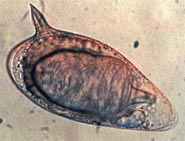
Back Schistosomatidae CEB Schistosomatidae Czech Schistosomatidae French Fuglablóðögður Icelandic 住血吸虫科 Japanese Schistosomatidae Dutch Schistosomatidae Portuguese Schistosomatidae Swedish Schistosomatidae Turkish Schistosomatidae WAR
| Schistosomatidae | |
|---|---|

| |
| Egg of Schistosoma mansoni | |
| Scientific classification | |
| Domain: | Eukaryota |
| Kingdom: | Animalia |
| Phylum: | Platyhelminthes |
| Class: | Trematoda |
| Order: | Diplostomida |
| Superfamily: | Schistosomatoidea |
| Family: | Schistosomatidae Stiles & Hassall, 1898 |
Schistosomatidae is a family of digenetic trematodes with complex parasitic life cycles. Immature developmental stages of schistosomes are found in molluscs and adults occur in vertebrates. The best studied group, the blood flukes of the genus Schistosoma, infect and cause disease in humans. Other genera which are infective to non-human vertebrates can cause mild rashes in humans.
Schistosomatids are dioecious (individuals are of separate sexes) which is exceptional with regards to their phylum, Platyhelminthes, in which most species are hermaphroditic (individuals possess both male and female reproductive systems).